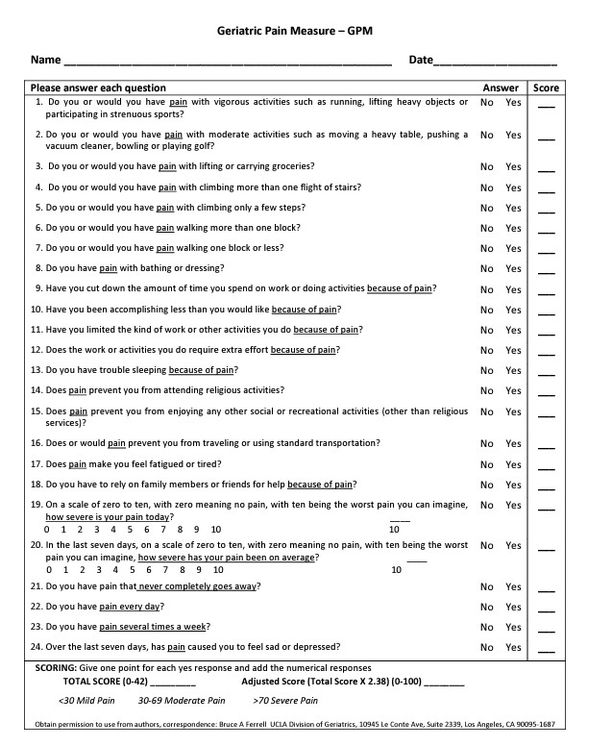Geriatrics Pain Measure: Difference between revisions
(Created page with "== Introduction == The Geriatric Pain Measure (GPM) was developed for multidimensional pain evaluation in the elderly, being easy to apply and understand<ref name=":0">1. ...") |
No edit summary |
||
| Line 1: | Line 1: | ||
== Introduction == | == Introduction == | ||
[[File:Geriatrics.jpg|thumb|746x746px]] | |||
The Geriatric Pain Measure (GPM) was developed for multidimensional pain evaluation in the elderly, being easy to apply and understand<ref name=":0">1. Motta TS, Gambaro RC, Santos FC. Pain measurement in the elderly: evaluation of psychometric properties of the Geriatric Pain Measure-Portuguese version. Revista Dor. 2015 Jun;16(2):136-41.</ref>. Most elderly population suffers of chronic pain, being that its prevalence among community elderly may vary from 25 to 50%. The practical guide for chronic pain in the elderly was developed and updated by the American Society of Geriatrics (1998 and 2002) and recommends that multidimensional tools should be used to evaluate pain quantification and approach in the elderly in a multidimensional manner and that they are culturally adapted for countries with languages different from English. | The Geriatric Pain Measure (GPM) was developed for multidimensional pain evaluation in the elderly, being easy to apply and understand<ref name=":0">1. Motta TS, Gambaro RC, Santos FC. Pain measurement in the elderly: evaluation of psychometric properties of the Geriatric Pain Measure-Portuguese version. Revista Dor. 2015 Jun;16(2):136-41.</ref>. Most elderly population suffers of chronic pain, being that its prevalence among community elderly may vary from 25 to 50%. The practical guide for chronic pain in the elderly was developed and updated by the American Society of Geriatrics (1998 and 2002) and recommends that multidimensional tools should be used to evaluate pain quantification and approach in the elderly in a multidimensional manner and that they are culturally adapted for countries with languages different from English. | ||
| Line 5: | Line 6: | ||
References | References | ||
<references /> | |||
Revision as of 14:18, 16 May 2019
Introduction[edit | edit source]
The Geriatric Pain Measure (GPM) was developed for multidimensional pain evaluation in the elderly, being easy to apply and understand[1]. Most elderly population suffers of chronic pain, being that its prevalence among community elderly may vary from 25 to 50%. The practical guide for chronic pain in the elderly was developed and updated by the American Society of Geriatrics (1998 and 2002) and recommends that multidimensional tools should be used to evaluate pain quantification and approach in the elderly in a multidimensional manner and that they are culturally adapted for countries with languages different from English.
GMP is a 24-item questionnaire that is easy to administer and has significant validity and reliability in older persons with multiple medical problems[2]. It addresses pain multidimensions, such as intensity (items 13, 17, 19, 20-23), “disengagement” (items 9-12, 15, 18, 24), pain at ambulation (items 4-7), pain at vigorous activities (items1-3) and pain during other activities (items 8, 13-16), involving sensory-discriminating, motivational-affective and cognitive-evaluative dimensions of pain, described by Melzack and Katz[1].
References
- ↑ 1.0 1.1 1. Motta TS, Gambaro RC, Santos FC. Pain measurement in the elderly: evaluation of psychometric properties of the Geriatric Pain Measure-Portuguese version. Revista Dor. 2015 Jun;16(2):136-41.
- ↑ 1. Ferrell BA, Stein WM, Beck JC. The Geriatric Pain Measure: validity, reliability and factor analysis. Journal of the American Geriatrics Society. 2000 Dec;48(12):1669-73.







